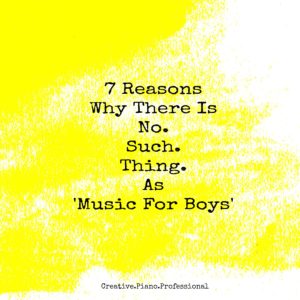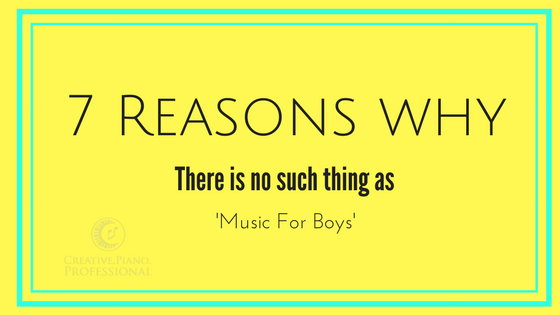For some time I have been grappling with the idea of ‘Music for Boys’. Each time I see a piece referred to as ‘For Boys’ or information published about how certain pieces would be great FOR BOYS I have an increasing sense that our industry is doing a great disservice to children by perpetuating gender stereotypes and limiting our students’ learning opportunities.
So here it is:
7 Reasons Why There Is No Such Thing As ‘Music for Boys’!
- There is no such thing as ‘girls’ music and ‘boys’ music. I’m fairly certain that Beethoven, Bach, Schumann, Kabalevsky, Rochelle and Milne didn’t compose their pieces with the idea of being gender divisive. They wrote music. Music to be learnt, performed, listened to and enjoyed by PEOPLE. Not a gender.
- Where is the evidence to suggest that this ‘music for boys’ provides better pedagogically sound education for boys? Show me the research that demonstrates there are better learning outcomes attained by a specific gender as a blanket rule when one style of music is played. Why is this a good idea?
- If I limit my students to playing works by one composer, era or genre, am I providing them with a well-rounded education? How is limiting boys or girls to a particular style if music in their best interests? Developing a student’s range and musical palette is a core responsibility of instrumental teachers.
- Believing that boys like fast, loud and driven songs suggests that this is exclusive to boys and that masculinity precludes the ability to create nuances and subtleties outside of this range. This also makes assumptions about the range of music that is ‘suitable’ for girls to learn, impeding them from expressing themselves with fast, driven and loud pieces. An educator’s perceptions and projections of gender stereotypes affect educational outcomes for students. Gender bias and stereotypes have no place in music education. Stop it.
- As educators we should be teaching an individual, not perpetuating social constructs of masculinity and femininity. The way a person learns and their unique circumstances should be the platform from which we develop personalised learning programs for students. Recently the ‘Like a Girl’ campaign demonstrated how these social gender constructs influence behaviour. Why would we seek to perpetuate such division with music?
- Segregating students through musical styles only serves to perpetuate stereotypes. If at recitals, the only students who perform fast, driven material are boys, this further enhances the masculine stereotype. Male and female members of the audience alike see the difference: boys play the ’masculine’ pieces; girls play the more ’feminine’ material. No. Just no. Stop it.
- Gender equality in the music industry is seriously lacking. The overwhelming majority of printed material is composed by males. Inclusion of female composers in list pieces for examination syllabi of major national examination boards is significantly lower than males and the numbers of educators in the piano teaching industry is overwhelmingly female dominant. The industry is already burgeoning with gender inequality. Teachers perpetuating the gender divide by promoting divisive masculine and feminine stereotypes only serve to further divide and limit the potential of our students and industry.
A student’s gender does not determine their educational path. Teach the individual.
We are educators, teaching individuals. So please, cease and desist with this ‘for boys’ concept.





As with most things out there today, there is a marketing ploy behind this targeting , anything to sell more widgets!
Like everything else in life we all should respect and enjoy diversity.
My little boy is learning the piano because I learnt music when I was a little girl. It is the music that is important – the joy for him comes from the moment when he masters a piece for the first time – sometimes the music is fast and sometimes it is slow… but the joy, the broad shoulders and feelings of accomplishment from his pieces being mastered are indeed the same for him. Everything is so gender specific today – music should not be – to be specific about music is not good for the soul, the mind nor our free spirit. Well done to you for speaking out.
Kylie, glad you enjoyed reading it! That internal sense of accomplishment is fantastic and vital for building confidence regardless of the gender of students.
This is brilliant Carly. I have the same “this isn’t right” feeling when those gender labels are thrown into schooling and music education. Gender is a social construct that is abused as a marketing tool. As teachers, we should be teaching each individual child and not labeling them in such a way. Really well said.
Thank you Thembi. I think your summary is correct with its origins in social construct and as a tool for marketing. Looking broadly at the consequences of such a device though is what worries me.
Great piece, glad you have put your thoughts out there into the wider community. Well done!
Thank you for instilling the concept 🙂
Thank you. As one of those girls who “played like a boy”, this is a breath of fresh air. There’s just kids and their personality, nothing else. We don’t need to limit and label at all, and especially not so young.
Yes indeed Sarah. It’s all about teaching the individual!